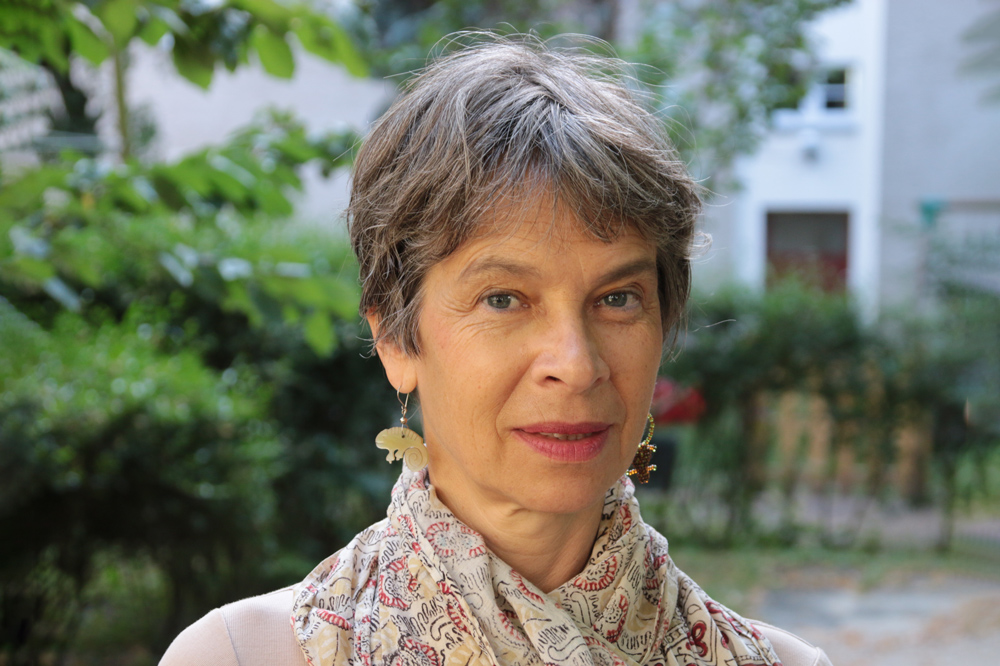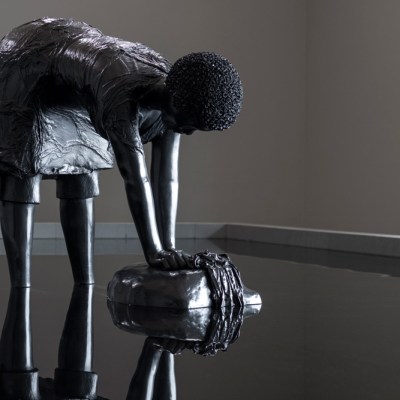Venice teems with exhibition space. It grows, like mould, in almost every inch not occupied by a two-star hotel, a blindingly lit ATM, or yet another souvenir shop selling captain’s hats or fake masks or quills and parchment. Most contemporary galleries are indistinguishable from one another, governed by the homogenising logic of mass tourism, which apparently selects for Jeff Koons, Carole Feuerman and, worst of all, Richard Orlinski. But a few independent venues stand out. One of the most consistently interesting is run by the Arsenale Institute for Politics of Representation on the ground floor of a building on the Riva dei Sette Martiri. The Institute, as you may have guessed from its formidable name, has academic origins, at the Iuav university in Venice, where it was founded in 2006 by Lewis Baltz, the architectural historian Marco de Michelis and the curator Wolfgang Scheppe.
Currently at the Institute is an invigorating show of work by Pomona Zipser. Its title, ‘Ponteggi Narrativi’ begs to be read in the broader Venetian context: the city has more than a thousand ponti and often bristles with ponteggio, or scaffolding. Even though this work is not explicitly in dialogue with the city, the artist spent some formative early months here in the 1980s and one of Zipser’s very first solo shows was in Paradiso Perduto, a famous dive bar on the spritz-washed Misericordia.
O.T. (2017), Pomona Zipser. Photo: Dave Grossman; courtesy Arsenale Institute for Politics of Representation

Zipser, who was born in Romania in 1958 but has lived in Germany for the last 50 years, is known as a sculptor. (She studied at the University of the Arts in Berlin with Lothar Fischer, a founder of the SPUR Group.) But she might be more accurately described as a bricoleuse, an assembler, crafter, junk visionary and virtuoso wielder of scissors and glue. Her sculptures are made from spindly pieces of wood painted rusty red, forest black and bone white, bound together with ropes, nails, wire and who knows what else. They lean against columns and balance on pointy tips and cantilever from high on the walls. They are funny and sad and sexy and morbid and daft and ingenious and primordial and futuristic all at the same time.
Zipser’s work feels like the improvised production of some cracked craftsperson. It has an intentional incompetence, a whimsical intensity. O.T. (2017), the largest piece here, is a kind of inverted tripod made of three long pieces of wood, painted the burnt-orange colour of the Golden Gate Bridge, which are bound together, toward the bottom, with tangles of rope and glue, with some blocks shoved in for good measure. The whole thing rests on the pointy tips of two of the poles; the other ends touch the ceiling. Anyone who has spent any time in Venice will immediately spot the resemblance to bricole, the weirdly primitive pylons fashioned, to this day, from three or more poles driven with a pile driver into the muddy laguna and then shackled together with metal, and sometimes even chains, by burly, red-faced workmen. Nearby, a much smaller piece that looks almost identical (not a copy, however, since it dates from 2013) stands on a pedestal, with additional legs that shoot off into nowhere, and three nails that jut out from the central piece of wood. Zipser calls it Roter Stern (‘red star’). To me, it looks more like a rusty praying mantis.
On the other side of the gallery stands Haus oder Weg (‘house or way’) from 2003, a square frame the size of a king-sized bed, and more than 50cm high, made of lanky wood planks painted ghostly white, held together with ridiculously complex joints made of pegs and dowels that can only be described as wooden knots. A few spindly boards reach into the middle, joining in a central snaggle with a few small feet that reach down to the concrete, like some sort of jerry-rigged support, in this antitype of an Ikea bed, for a missing mattress. From the bottom right corner, a little useless board, sharpened to a point, gestures toward the centre. The whole thing looks like it’s about to fall apart. Once you stop marvelling at the strangeness of it and remember the title, you feel the inscrutable melancholy that subtends its wit. Who knew that something made of little more than driftwood could convey so much pathos, could seem to slouch like some tired old animal?
Haus oder Weg (‘house or way’; 2003), Pomona Zipser. Photo: Arsenale Institute for Politics of Representation

It’s posture, or pose, that makes some of these sculptures so good, and so inexplicably alive. A number of them – a long angular squiggle that looks like a flattened Max Ernst bird sculpture; or another with a wooden handle and a broad, oar-like wing made of a collage of cardboard – lean against walls around the gallery, in attitudes that makes them seem much less like mere objects and more like creatures. Some spiky pieces are perched like toucans or macaws from the rafters, in a gesture that is also distinctly creaturely.
Hanging on the walls are Zipser’s wonderfully trashy collages of cardboard and waste paper, angular black figures that share a geometrical grammar with the sculptures; they look like recycled Rorschach blots, or a fully abstracted version of William Kentridge’s puppet drawings. More striking are reliefs from single pieces of paper, which Zipser cuts and folds into abstract plots that look like maps of imaginary places, or sometimes even little narrative scenes. If her sculptures do a lot with a little, these cut-outs do the most with the least. One piece called Die Wichtigsten Dinge (‘the most important thing’; 2019), which can be seen in an upstairs room of the gallery upon request, is a kind of Flatland narrative of two lovers and their family; but my preference is for the non-figurative work, such as Im Schloß öffnen sich die Fenster (‘windows opening in the castle’; 2018), a stunning window-sized cut-out, stretched like a hide on a spindly wooden frame, whose large central opening, like a J turned 90 degrees clockwise, divides the area as the Grand Canal divides Dorsoduro and San Polo from San Marco.
Im Schloss öffen sich die Fenster (‘windows opening in the castle’; 2018), Pomona Zipser. Photo: Arsenale Institute for Politics of Representation

There is so much more to say about this self-assured artist, but even more to see, and to see again beneath the buildings and bridges and people you encounter when you leave the door. ‘Ponteggi Narrativi’ is an assemblage of skeleton keys, a boneyard of dead metaphors, a carefully suspended constellation of flotsam and jetsam – much like Venice itself.
‘Ponteggi Narrativi’ at the Arsenale Institute for Politics of Representation in Venice until 10 September, by appointment.

